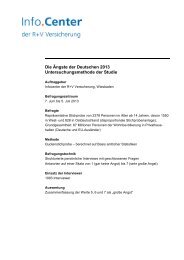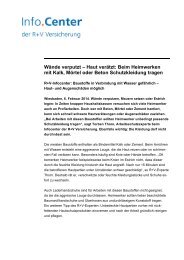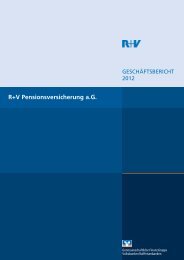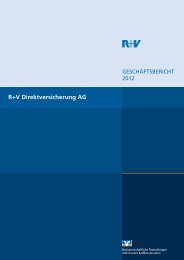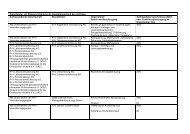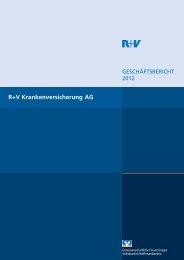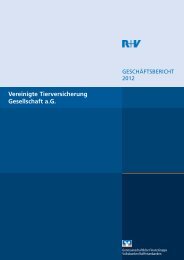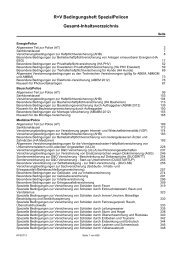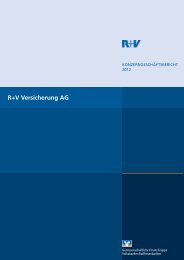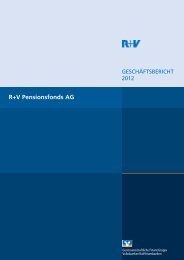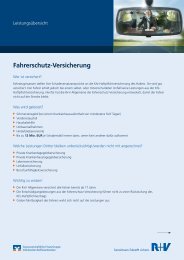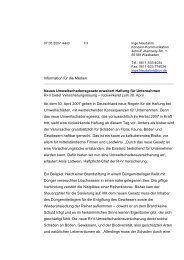Annual Report 2011 - R+V Versicherung
Annual Report 2011 - R+V Versicherung
Annual Report 2011 - R+V Versicherung
You also want an ePaper? Increase the reach of your titles
YUMPU automatically turns print PDFs into web optimized ePapers that Google loves.
70<br />
Glossary<br />
Glossary<br />
Accumulation<br />
Accumulation describes several risks insured or reinsured by the<br />
same insurance company that could be affected by one loss<br />
event simultaneously.<br />
Affiliated companies<br />
The parent company (group controlling company) and all subsidiaries.<br />
Subsidiaries are companies over which the parent<br />
company can exert a dominant influence on business policy<br />
(control principle). This is possible, for example, if the group<br />
parent holds the majority of voting rights either directly or indirectly<br />
or has the right to appoint or dismiss the majority of the<br />
members of company bodies (management board, supervisory<br />
board) or if there is a contract of domination.<br />
Assumed business<br />
A transaction concluded between two insurance companies.<br />
It is synonymous with with the forwarding of part of the loss<br />
distribution assumed from the policyholder from the direct<br />
insurance company to a reinsurance company.<br />
Balance sheet loss ratio gross<br />
Expenditure on claims in relation to earned premiums –<br />
all gross.<br />
Balance sheet loss ratio net<br />
Expenditure on claims in relation to earned premiums – all net.<br />
Black Formula 76<br />
The Black Formula 76 is a finance mathematical model used to<br />
value interest options, which was published by Fischer Black in<br />
1976.<br />
Black-Scholes model<br />
The Black-Scholes model is a finance mathematical model used<br />
to value financial options, which was published by Fischer Black<br />
and Myron Scholes in 1973.<br />
Combined Ratio<br />
Percentage relationship of the total of expenditure on claims<br />
plus expenditure on insurance operations to earned premiums –<br />
all net. This is equivalent to the total of the loss and cost ratio.<br />
This is an important key performance indicator when considering<br />
the profitability of a policy, a sub-portfolio or a complete<br />
insurance portfolio. If this figure exceeds 100% it results in an<br />
actuarial loss for the transaction in question.<br />
Cost ratio gross<br />
Percentage ratio for expenditure on insurance operations in<br />
relation to earned premiums – all gross.<br />
Cost ratio net<br />
Expenditure on insurance operations in relation to earned<br />
premiums – all net.<br />
Current value<br />
The current value of a capital investment is usually equivalent<br />
to its market value. If the value cannot be calculated directly,<br />
the value at which the asset is traded between expert business<br />
partners who are independent of each other and willing to<br />
conclude a contract can be of assistance.<br />
Deferred tax (assets/liabilities)<br />
There is deferred tax in a financial statement if there are differences<br />
between the valuations of asset items and debts in the<br />
commercial accounting and the tax accounting. By using<br />
the deferred tax approach, future tax charges (deferred tax<br />
liabilities) or refunds (deferred tax assets) will be formed in<br />
the commercial accounting.<br />
Deposit receivable and liabilities<br />
Security payments to cover actuarial liabilities between direct<br />
insurers and reinsurers. In this case the retaining company<br />
reports deposit liabilities and the ceding company reports<br />
deposit receivables.



